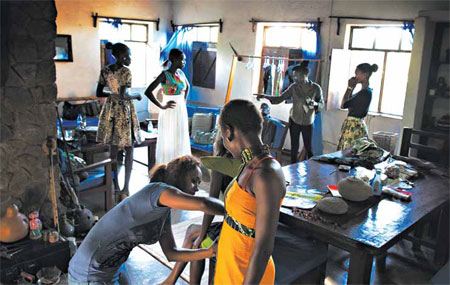Remodeling a nation
Updated: 2013-10-20 08:02
By Nicholas Kulish(The New York Times)
|
|||||||
On a runway, creating an identity Juba, South Sudan
Even by the standards of fashion models, the women teetering in their high heels on the dirt catwalk here were remarkably tall and slender. But judging by South Sudan's many towering inhabitants, they were hardly out of the ordinary in the young nation's capital.
As the rehearsal at the Bedouin Lodge progressed, Akuja de Garang, the organizer of the event, was less concerned with her regal beauties than with one of the men in her fashion show. "That's my male model, you see? The one in the orange," she said, gesturing toward a young man.
The question was whether he would be willing to appear in front of an audience shirtless except for a traditional Dinka beaded corset. "Is he brave enough to do it?" Ms. Garang asked.
The success of the country's most famous supermodel, Alek Wek, notwithstanding, the most common images of South Sudan are still armed rebel fighters or malnourished children.
With her Festival for Fashion and Arts for Peace, now in its second year, Ms. Garang, 38, is trying to change not just outside perceptions, but also the way people here see themselves and one another, especially in a nation still rattled by interethnic tension and violence.
"There are still problems. Partly that's because we don't have a sense of common identity as South Sudanese," said Ms. Garang. "We've been scattered for so long. What we hear about each other are stereotypes."
The fashion show in August was only part of the event drawing South Sudanese from all over the country, many flown into the capital on United Nations planes, including drummers and dancers, singers and rappers, as well as an arts and crafts display.
"South Sudan has been at war for a very long time," said Ellen Lekka, a culture specialist at Unesco, a sponsor of the event. "Traditions that go from generation to generation might have been lost in the struggle for survival and migration."
There are few paved roads in Juba, but apartment blocks, hotels and even 10-story office buildings are sprouting up.
"When we compare Juba from the year before we
were called South Sudan, there is a great change," said Davidica Ikai, chairwoman of the Itwak Women's Group, one of the groups displaying and selling wares at the festival.
Mer Ayang, a singer who performed at the event, said she hoped the development in the capital would not come at the expense of the rest of the country. "I would judge my country in terms of development on better schools, hospitals, streets and public services," she said.
Eva Logune, a South Sudanese model based in Malaysia, said the fashion and arts event was a chance to showcase another side of the country for a change.
"Even five years ago, all you could hear about Juba or South Sudan was people are starving, people are dying," said Ms. Logune, who models under the name Eva Lopa. "This shows we're not all about violence."
Decades of civil war created millions of internally displaced people and refugees, many living in neighboring Kenya or Ethiopia, or in South Africa, the United States and Canada.
Ms. Garang was born in Juba and moved as a child to Khartoum, Sudan's capital, after her father died. When she was 18, she and her mother moved to Cairo, where at first she had to work as a cleaner. Because she spoke English well, she was able to find a better job as a receptionist, but she still remembers the casual racism that confronted her while riding the bus in Egypt.
She moved again, to Britain, eventually earning a master's degree from the University of London's School of Oriental and African Studies. She returned to what was then southern Sudan just before the Comprehensive Peace Agreement that charted the course for independence was signed in January 2005.
Through her work with the United Nations and nonprofit groups, Ms. Garang traveled the country, collecting so many artifacts she turned her home into a mini-gallery. She combined her hobby of collecting with her interest in fashion to organize the first fashion show last year, which she paid for.
This year's clothes, all locally designed except for a line by an Ethiopian, blended traditional African fabrics with more modern cuts. The models had not developed the cool nonchalance of their counterparts in Paris or Milan yet, and were dancing behind the curtain to Nicki Minaj's song "Starships" as they waited to go on.
A female model with a shaved head and an extra-bouncy strut consistently got the loudest applause. The loudest, that is, until Ms. Garang's male model appeared, his broad shoulders and chest bare, and his waist hugged only by bright orange, yellow and blue beads, to gaping stares from the men and whooping cheers from the women.
"It's something I feel I have to do," Ms. Garang said. "So far, it looks like people enjoy it."
The New York Times
|
A fashion show in Juba drew designers, musicians and artists from all over South Sudan, a nation better known for war than beauty. Camille Lepage for The New York Times |
(China Daily 10/20/2013 page9)
